Honing your dog's water work is a fine way to both train and exercise him during the hot summer months.
By James B. Spencer
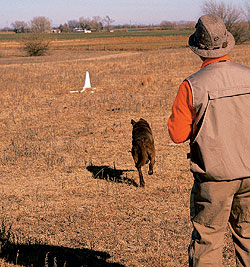 Before asking your retriever to do a water pattern blind, teach him the same one on land. |
It is summertime. The heat's on and, for working retrievers, just staying alive ain't no cinch. Since dogs don't sweat, they can overheat much more quickly than we humans. What's more, an overheated dog can die in a heartbeat--literally--if not cooled down pronto.
The fastest, surest way to do this is to soak the overheated beastie thoroughly with water, either by pouring it over him or by having him lie down in shallow water. However, it's far safer to prevent canine overheating in the first place, which you can do by making your summer training sessions mostly water work. Thus, summertime is ideal for polishing your retriever's water marks and water blinds. Water marks are no great mystery, so let's concentrate here on drills to polish your dog's water blinds.
First the prerequisites: Before you can introduce him to any water blind drill, your retriever must be reasonably competent at a similar drill on land. We teach on land and then transfer the learning to water.
Visual Aid Pattern Blinds
In this drill, you start by "lining" your retriever to a dummy pile marked with a white object (traffic cone, bucket or whatever). After his first successful run, you remove the visual aid and rerun him to the unmarked dummy pile, and so on. You do this on land until he is conditioned to take off in a straight line, with or without a visual aid, when you send him with your blind retriever sequence ("Dead bird€¦Good€¦Back!").
Here we'll assume you've reached that point on land and feel your dog is ready for visual aid pattern blinds in water. (For complete coverage of the visual aid pattern blind concept, see my books, Training Retrievers for Marshes and Meadows and Retriever Training Drills for Blind Retrieves.)
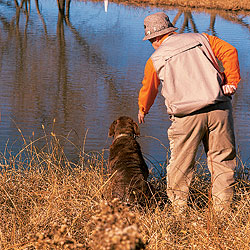 "Dead bird€¦Good€¦" |
Initially, set this drill up in a pond where your dog won't have to swim more than about 50 yards. Put the dummy pile and visual aid on the shore opposite your intended line (or starting point). Then heel your dog to the line, let him lock in on the visual aid and then send him with your blind retrieve sequence. If he's ready for this drill, he'll jump right in and swim to the visual aid, where he'll pick up a dummy and bring it back to you.
Now put him up while you remove the visual aid from the dummy pile. Heel your dog to the line again and send him once more with your blind retrieve sequence. He knows where the dummy pile is, so he'll jump in and swim straight to it. Rerun him a couple more times, and then give him a good rest. You've just taught him a pattern blind, to which you can (and should) return from time to time to rerun him, always without the visual aid.
In your next session go to a new location and repeat the entire process, thereby teaching him another pattern blind. Always quit for the day when he's still eager for more, and always end the session with a few "fun dummies" to give him happy memories of the training session.
 "€¦Back!€¦" |
After you've established three or four pattern blinds this way, change your routine. Start each session by establishing a new pattern blind, and then go back and rerun two or three of your old ones (without the visual aid). These frequent "milk routes" from one well-established pattern blind to another will build your dog's confidence. It'll convince him that, when you utter your blind retrieve sequence, all he has to do to find a dummy (or bird) is swim far enough in a straight line.
Thrown Pattern Blinds
In this drill, you have an assistant hide in a location from which he can throw a dummy into the water when you signal him. Optionally, you can use an electronic remote multi-shot dummy launcher, which gives you total control over the timing of the "throw."
Initially, set your dog up at the line, which should be several yards back from shore.
Immediately initiate a throw, electronically or by signaling your assistant. When the dummy hits the pond, send your dog for it as a mark (which it is). Then again set your dog up at the line and this time send him with your blind retrieve sequence, delaying the throw until he reaches the water's edge. He'll see the dummy fly, jump right in and go get it.
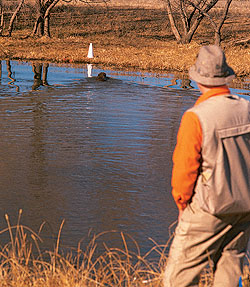 €¦Success! |
The next time, after sending him, delay the throw a little longer. And so on until you can delay the throw until your dog is quite close to where the dummy will fall. (Nota bene:
Don't wait too long, for you don't want the dummy to land on your dog and perhaps frighten him.) Since in the initial session you must repeat this drill three to five times to get your retriever to swim a reasonable distance before the throw, you should make it a relatively short swim, only about 40 yards.
In your next session set up in a new location. In your first run, after sending your dog, delay the throw until he reaches the water's edge. Then, in reruns, delay the throws longer and longer, as you did before. Then, after resting him, go back to the site of your first session and rerun that thrown blind, delaying the throw as long as possible.
In your next session, set up in a new location, send him and delay the first throw as long as possible, in fact until he either reaches the "drop zone" or becomes uncertain. Then rerun him a time or two to cement this blind in his mind. Since you won't have to repeat it so often, you can make it longer, perhaps 60 yards. Then go back to your previous locations and rerun those two blinds until you've created several pattern blinds of this sort that you can use as a "milk route."
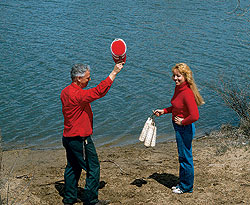 Before running a thrown pattern blind, show your assistant how you will signal for a throw. |
These thrown pattern blinds have one very significant advantage, in that your dog always finds the dummy in the water, not on land as he does in visual aid pattern blinds. Finding blind retrieves in the water lessens his inclination to run the bank.
Inverted-T Handling Drill
For this, you need a small pond, preferably oval-shaped, about 40 by 60 yards. Set the line up in the middle of one shoreline, and put out three dummy piles marked by visual aids: one (for the Back cast) about 40 yards back from the opposite shoreline; and one near the water's edge at each end of the pond (for the Over casts).
Heel your dog, not to the line, but to a position on the opposite shoreline directly between the line and the Back dummy pile. Leave him there in a Sit-Stay and walk back around the pond to the line. Give your dog a Come-in cast. After he enters the water, toss a dummy into the pond a short distance straight in front of you. After he delivers it to you, heel him back around to his starting position, leave him in a Sit-Stay and return to the line.
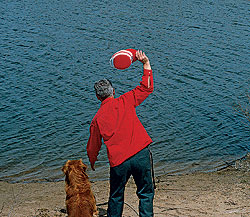 On the first run, signal for the throw before sending your retriever. |
Again, toot the Come-in whistle, but this time throw nothing. When he reaches the middle of the pond, blow the Stop-whistle, and cast him to any of the three dummy piles.
After he delivers the dummy, heel him back to his starting position, leave him in a Sit-
Stay, walk back around to the line, give him another Come-in cast, stop him in the middle and cast him to a different dummy pile. Repeat this until he's comfortable taking your cast to any of the three dummy piles. That may take two or three sessions.
Thereafter, repeat this drill, but without the visual aids. Each time, vary the sequence of your casts. If you can find other locations suitable for this drill, use them. The more places you have, the better.
Unlike the regular T drill (in which you send your dog from the line, stop him in the middle of the pond and cast him), this inverted-T drill doesn't encourage popping (stopping without the Stop-whistle), which can become a nasty problem. True, you could overcome it with the e-collar, but why not prevent it instead?
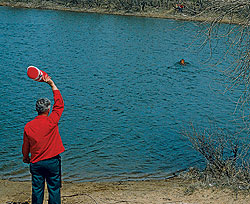 After a couple of runs, delay signaling for the throw as long as possible, in fact until your retriever begins to waver. |
These summertime water drills will keep your pooch cool while you teach him how to pick up birds reliably in real blind retrieves next hunting season.
Jim Spencer's books can be ordered from the Gun Dog Bookshelf: Training Retrievers for Marshes & Meadows, Retriever Training Tests, Retriever Training Drills for Marking, Retriever Training Drills for Blind Retrieves, HUP! Training Flushing Spaniels the American Way, POINT! Training the All-Seasons Bird Dog and the Gun Dog video, Duck Dog.






